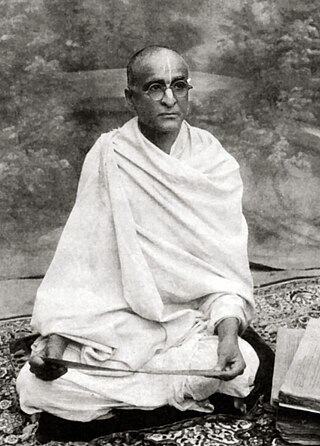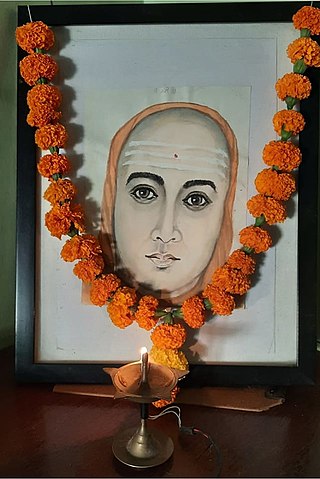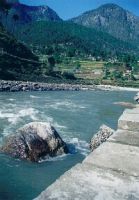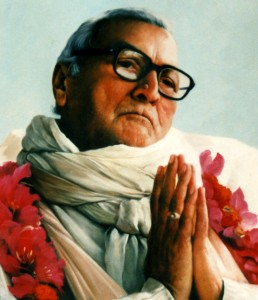
Chaitanya Mahaprabhu, born Vishvambhar Mishra, was a 15th-century Indian Hindu saint from Bengal who was the founder of Gaudiya Vaishnavism, which considers him to be an incarnation of Krishna.

Bhaktisiddhanta Sarasvati, born Bimala Prasad Datt, was an Indian Gaudīya Vaisnava Hindu guru, ācārya, and revivalist in early twentieth-century India. To his followers, he was known as Srila Prabhupāda.

Gaudiya Vaishnavism, also known as Chaitanya Vaishnavism, is a Vaishnava Hindu religious movement inspired by Chaitanya Mahaprabhu (1486–1534) in India. "Gaudiya" refers to the Gaura or Gauḍa region of Bengal, with Vaishnavism meaning "the worship of Vishnu". Specifically, it is part of Krishnaism—Krishna-centric Vaishnavite traditions.

Dattatreya, Dattā or Dattaguru, is a paradigmatic Sannyasi (monk) and one of the lords of yoga, venerated as a Hindu god. He is considered to be an avatar and combined form of the three Hindu gods Brahma, Vishnu, and Shiva, who are also collectively known as the Trimurti, and as the manifestation of Parabrahma, the supreme being, in texts such as the Bhagavata Purana, the Markandeya Purana, and the Brahmanda Purana, though stories about his birth and origin vary from text to text. Several Upanishads are dedicated to him, as are texts of the Vedanta-Yoga tradition in Hinduism. One of the most important texts of Hinduism, namely Avadhuta Gita is attributed to Dattatreya. Over time, Dattatreya has inspired many monastic movements in Shaivism, Vaishnavism, and Shaktism, particularly in the Deccan region of India, Maharashtra, Gujarat, Madhya Pradesh, Rajasthan and Himalayan regions where Shaivism is prevalent. His pursuit of simple life, kindness to all, sharing of his knowledge and the meaning of life during his travels is reverentially mentioned in the poems by Tukaram, a saint-poet of the Bhakti movement.
Goswami is an Indian surname. It is also pronounced as, Gosains, Gosine, Gossain, Gosain, Gossains and Gosavi.

Satsvarupa das Goswami is a senior disciple of Bhaktivedanta Swami Prabhupada, who founded the International Society for Krishna Consciousness (ISKCON), better known in the West as the Hare Krishna movement. Serving as a writer, poet, and artist, Satsvarupa dasa Goswami is the author of Bhaktivedanta Swami's authorized biography, Srila Prabhupada-lilamrta. After Prabhupada's death, Satsvarupa dasa Goswami was one of the eleven disciples selected to initiate future disciples. Satsvarupa dasa Goswami is one of the first few Westerners ordained by Bhaktivedanta Swami in September 1966. He is a Vaishnava writer, poet, and lecturer, who published over a hundred books including poems, memoirs, essays, novels, and studies based on the Vaishnava scriptures.

Kṛṣṇadāsa Kavirāja Gosvāmī was the author of the Caitanyacaritāmṛta, a biography on the life of the mystic and saint Caitanya Mahāprabhu (1486–1533), who is considered by the Gaudiya Vaishnava school of Hinduism to be an incarnation of Rādhā and Kṛṣṇa combined.

The Gaudiya Math is a Gaudiya Vaishnava matha formed on 6 September 1920, about 30 months after Bhaktisiddhanta Sarasvati took sannyasa, the renounced order of life. On 7 March 1918, the same day he took sannyasa, he established the Sri Chaitanya Math in Mayapura in West Bengal, later recognised as the parent body of all the Gaudiya Math branches. Its purpose was to spread Gaudiya Vaishnavism, the philosophy of the medieval Vaisnava saint Chaitanya Mahaprabhu, through preaching and publishing.
The Shri Guru Charitra is a book based on the life of Shri Nrusimha Saraswati, written by the 15th-16th century poet Shri Saraswati Gangadhar.

Shree Narasimha Saraswati Swami or Shree Nrusimha Saraswati Swami was an Indian guru of Dattatreya tradition(sampradaya). According to the Shri GuruCharitra, he is the second avatar of Dattatreya in Kali Yuga after Sripada Sri Vallabha.

Bhakti Hridaya Bon, also known as Swami Bon, was a disciple of Bhaktisiddhanta Sarasvati and a guru in the Gaudiya Math following the philosophy of the Bhakti marg, specifically of Caitanya Mahaprabhu and Gaudiya Vaishnava theology. At the time of his death, he left behind thousands of Bengali disciples in India.

Vishnujana Swami, born Mark Stephen D'Atillo, was a disciple of A. C. Bhaktivedanta Swami Prabhupada, and a sannyasi within the International Society for Krishna Consciousness who disappeared in 1976. He made recordings of himself singing the Hare Krishna mantra.

The Tirtha lineage of Siddhayoga is a mystical sect of Shaivite Hinduism. It believes in direct encounters with life-force or kundalini shakti, and understanding of the Shastras. It places importance on the guru-disciple bond, as, according to this tradition, the guru transfers shakti, the divine energy, to the disciple through a transformative process known as Shaktipat. Shakti is said to be automatically infused into a disciple by a guru in a process called Shaktipat.

The Advaita Guru-Paramparā is the traditional lineage (parampara) of divine, Vedic and historical teachers of Advaita Vedanta. It begins with the Daiva-paramparā, the gods; followed by the Ṛṣi-paramparā, the Vedic seers; and then the Mānava-paramparā, with the historical teachers Gaudapada and Adi Shankara, and four of Shankara's pupils. Of the five contemporary acharyas, the heads of the five Advaita mathas, four acharyas trace their lineage to those four pupils and one to Adi Shankara himself.

Bijoy Krishna Goswami, also known by the honorific Gosaiji, was a Hindu social reformer and religious figure in India during the British period.

Uttarāmnāya Śrī Jyotish Pītham or JyotirMath is one amongst the four cardinal pīthams established by the Ādi Śaṅkara to preserve and propagate Hinduism and Advaita Vedānta, the doctrine of non-dualism. Located in the city of Joshimath, Chamoli district, Uttarakhand, India, it is the uttarāmnāya matha or Northern Āmnāya Pītham, amongst the four Chaturamnay Peethams and in later period, Moolamnaya Sarvajna Peetham was declared as Moolamnay by disciples which is in Kalady, Kerala, birth place of Adi Shankara with the others being the Sringeri Śārada Pīṭhaṃ (Karnataka) in the South, Dvārakā Śāradā Pītham in the West and Purī Govardhanmaṭha Pīṭhaṃ in the east. Its appointees bear the title of Shankaracharya. It is the headquarters of Giri, Parvata & Sagara sects of the Dasnami Sampradaya. Their Vedantic mantra or Mahavakya is Ayamātmānam brahma and as per the tradition initiated by Adi Shankara it holds authority over Atharva Veda. The head of the matha is called Shankaracharya, the title derives from Adi Shankara.

Dr. Satyanarayana Dasa is an Indian Gaudiya Vaisnava scholar and practitioner. Dasa is a polymath, holding a Ph.D. in Sanskrit from Agra University, a degree in Indian law from Agra University, a Bachelors of Technology in Mechanical engineering from the Indian Institute of Technology and a Masters of Technology in Industrial Engineering from the Indian Institute of Technology. Currently based in India at the Jiva Institute, which he founded, Dasa has published numerous books and original papers in the field of Gaudiya Vaisnavism including translations and commentaries on the Sat Sandarbhas. His honors include an award from the President of India in 2012. Dasa has been called a leading living practitioner-scholar of Jīva Gosvāmin.

Shri Haridas Shastri (1918-2013) was an Indian Gaudiya Vaisnava scholar and practitioner. A prolific Sanskrit scholar, he wrote more than a sixty books, including translations from the Sanskrit of several Gauḍīya books and his own commentaries on them. His original works include the highly regarded book, the Vedānta-darśanam bhāgavata bhāṣyopetam, his translation-cum-commentaries of the Sat Sandarbhas, and his transliterations of Śrī-caitanya-bhāgavata, Śrī-caitanya-caritāmṛta and Śrī-caitanya-maṅgala. Jonathan Edelmann at the University of Florida has called Śāstrī "arguably the most prolific and well-educated Gauḍīya Vaiṣṇava “insider” scholar of the twentieth century" and "a voice distinct from the more well known Gaudīya-Maṭha and ISKCON". Among his disciples is the noted Gauḍīya scholar and practitioner, Dr. Satyanarayana Dasa.

Bhakti Rakshak Sridhar was an Indian guru, writer, sannyasi and spiritual leader in the Gaudiya Vaishnava tradition of Chaitanya Mahaprabhu, founder-president-acharya of the Sri Chaitanya Saraswat Math.
















